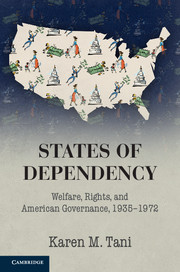Book contents
- Frontmatter
- Dedication
- Contents
- List of figures and tables
- List of gallery images
- Acknowledgments
- Introduction
- PART I 1935 TO 1949
- 1 A New Deal for Poor Relief? The Modern American State and the Endurance of the Local
- 2 Rights as an Administrative Tool: An Appeal to State and Local Bureaucrats
- 3 Rights as a “Live, Motivating Principle”: The Path toward Legalism
- 4 Claiming Welfare Rights: Fair Hearings, State-Court Claims, and a Forgotten Federal Case
- PART II 1950 TO 1972
- Conclusion
- Notes
- Selected Bibliography of Primary Sources
- Index
- Plate section
3 - Rights as a “Live, Motivating Principle”: The Path toward Legalism
from PART I - 1935 TO 1949
Published online by Cambridge University Press: 05 April 2016
- Frontmatter
- Dedication
- Contents
- List of figures and tables
- List of gallery images
- Acknowledgments
- Introduction
- PART I 1935 TO 1949
- 1 A New Deal for Poor Relief? The Modern American State and the Endurance of the Local
- 2 Rights as an Administrative Tool: An Appeal to State and Local Bureaucrats
- 3 Rights as a “Live, Motivating Principle”: The Path toward Legalism
- 4 Claiming Welfare Rights: Fair Hearings, State-Court Claims, and a Forgotten Federal Case
- PART II 1950 TO 1972
- Conclusion
- Notes
- Selected Bibliography of Primary Sources
- Index
- Plate section
Summary
On May 15, 1947, shortly after President Truman sounded the opening bell in what would become the Cold War, the Social Security Board's Bureau of Public Assistance announced the theme for that year's series of professional staff meetings: “The Right to Public Assistance.” The choice fit the times. Just weeks later, a high-profile commission of the United Nations would begin drafting a Universal Declaration of Human Rights. A presidentially appointed Committee on Civil Rights, meanwhile, was tackling America's widely recognized “Negro problem.” And within the world of public welfare, rights language was fast becoming a staple of federal-state communications.
The right to public assistance was also an apt topic for study in 1947 because it seemed so elusive. About a month before the bureau's announcement, prominent social work educator and former government administrator Donald Howard appeared before the National Conference of Social Work with a set of disturbing stories. One was about a public assistance officer who kept on his wall, just opposite the door, “the pictures of six Negroes whom he had helped to ‘send over the road’” – by which he meant helped send to prison, presumably for defrauding the agency. The officer posted the pictures because of the “sobering effect” he thought they had on black Americans seeking assistance. Howard described another welfare administrator who wrote complaint letters to himself from a fictitious “Citizens Committee” whenever he saw a public assistance recipient driving an automobile or drinking in a bar. These would be presented to the profligate individual as evidence that the community's sympathy had worn thin. So much the better if the applicant pleaded for reconsideration: the administrator would give him the opportunity to swear “never again [to] visit a tavern or drive a car,” after which something might be done to get him back on the relief rolls.
Less disturbing but far more pervasive were the accounts of “grossly inadequate” benefit levels and long waiting times between applications and aid. “Sure, there's a tree that grows in Brooklyn,” Howard noted, referencing Betty Smith's popular 1943 novel about a family flourishing amid poverty, but “there are many more that wither and die.” America could do better, he stressed, and so could federal aid administrators.
- Type
- Chapter
- Information
- States of DependencyWelfare, Rights, and American Governance, 1935–1972, pp. 81 - 112Publisher: Cambridge University PressPrint publication year: 2016

